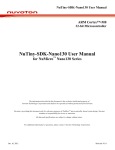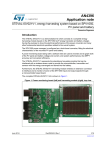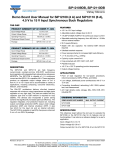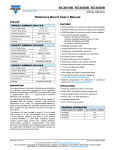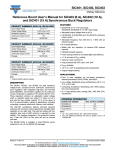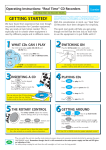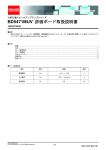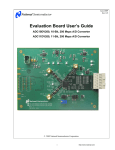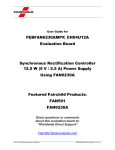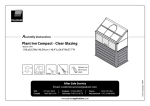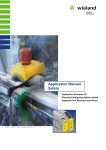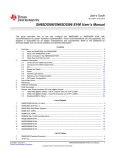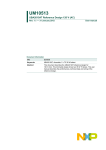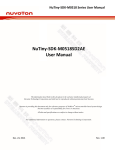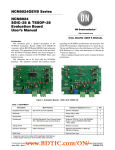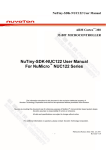Download SiP12107DB, SiP12108DB Demo Board User Manual for SiP12107
Transcript
SiP12107DB, SiP12108DB www.vishay.com Vishay Siliconix Demo Board User Manual for SiP12107 (3 A) and SiP12108 (5 A), 2.7 V to 5.5 V Synchronous Buck Regulators THE CHIP DESCRIPTION FEATURES The SiP12107/SiP12108 is a high frequency current-mode constant on-time (CM-COT) synchronous buck regulator with integrated high-side and low-side power MOSFETs. Its power stage is capable of supplying 5 A (3 A for the SiP12107) continuous current at 4 MHz switching frequency. This regulator produces an adjustable output voltage down to 0.6 V from a 2.8 V to 5.5 V input rail to accommodate a variety of applications, including computing, consumer electronics, telecom, and industrial. • 2.8 V to 5.5 V input voltage SiP12107/SiP12108's CM-COT architecture delivers ultra-fast transient response with minimum output capacitance and tight ripple regulation at very light load. The part is stable with any capacitor type and no ESR network is required for loop stability. The device also incorporates a power saving scheme that significantly increases light load efficiency. The SiP12107/SiP12108 integrates a full protection feature set, including output overvoltage protection (OVP), output undervoltage protection (UVP) and thermal shutdown (OTP). The “A” version of the 5 A device, the SiP12108A, does not have the UVP feature. The devices also incorporate UVLO for the input rail and an internal soft-start ramp. The SiP12107/SiP12108/SiP12108A are available in a lead (Pb)-free power enhanced 3 mm x 3 mm QFN-16 package. • Adjustable output voltage down to 0.6 V • 3 A continuous output current for SiP12107 • 5 A continuous output current for SiP12108A • Programmable switching frequency up to 4 MHz • 95 % peak efficiency • Stable with any capacitor. No external ESR network required • Ultrafast transient response • Selectable power continuous mode saving (PSM) mode or forced • ± 1 % accuracy of VOUT setting • Pulse-by-pulse current limit • SiP12107 / SiP12108 is fully protected with OTP, SCP, UVP, OVP • SiP12108A is fully protected with OTP, SCP, OVP • PGOOD indicator • PowerCAD simulation software available at www.vishay.transim.com/login.aspx • Material categorization: For definitions of compliance please see www.vishay.com/doc?99912 APPLICATIONS Point of load regulation for low-power processors, network processors, DSPs, FPGAs, and ASICs • Low voltage, distributed power architectures with 3.3 V or 5 V rails • Computing, broadband, networking, LAN/WAN, optical, test and measurement • A/V, high density cards, storage, DSL, STB, DVR, DTV, Industrial PC ORDERING INFORMATION DEMO BOARD PART NUMBER Revision: 22-Jan-14 MAX. OUTPUT CURRENT SiP12107DB 3A SiP12108DB 5A Document Number: 62924 1 For technical questions, contact: [email protected] THIS DOCUMENT IS SUBJECT TO CHANGE WITHOUT NOTICE. THE PRODUCTS DESCRIBED HEREIN AND THIS DOCUMENT ARE SUBJECT TO SPECIFIC DISCLAIMERS, SET FORTH AT www.vishay.com/doc?91000 SiP12107DB, SiP12108DB www.vishay.com Vishay Siliconix POWER UP PROCEDURE CHANGING SWITCHING FREQUENCY This reference board allows the end user to evaluate the SiP12107/SiP12108 chip for its features and all functionalities. It can also be a reference design for a user's application. To turn-on the reference board, apply a voltage between 2.8 V and 5.5 V to VIN and EN pins, the board will come up in PWM mode with an output voltage preset to 1.8 V. To disable the part, tie the EN pin to GND. To set the part into power save mode, tie the AUTO pin to GND. This will allow much higher efficiency due to a very lower switching frequency at very light loads. As the load increases the frequency will increase until the nominal set frequency (preset to ~1 MHz) is reached. PGOOD indicator can be probed from PGOOD pin. The following equation illustrates the relationship between ON-time, VIN, VOUT and RON value: V tON = RON x K x OUT VIN where K is a constant set internally (K = 10.45 x 10-12). Once ON time is set, pseudo constant frequency is then determined by the following equation: Fsw = D tON = VOUT VIN VOUT x RON x K VIN 1 = RON x K SPECIFICATION OUTPUT RIPPLE VOLTAGE Input voltage : 2.8 V to 5.5 V Output voltage: 0.6 V to 3.3 V Output ripple voltage can be measured across J2 and J3, but it is better to use a tip and barrel measurement since the ripple will be very small. Typically output ripple voltage is set to 3 % to 5 % of the output voltage, with an all ceramic output solution the output ripple can be very small. Voltage mode based COT controllers will have stability issues with an all ceramic solution, because they require the ripple voltage to provide the ramp needed by the controller. This is not a problem for the SiP12107/SiP12108 which are current mode COT controllers. The SiP12107/SiP12108 can work with any type of output capacitors that suit your needs. Output current: 0 A to 3 A for SiP12107, and 0 A to 5 A for SiP12108/SiP12108A CONNECTION AND SIGNAL/TEST POINTS Power Test Points VIN (J1), GND (J4): Input voltage source with VIN to be positive. Connect to a 2.8 V to 5.5 V source that powers SiP12107/SiP12108. VOUT (J2), GND (J3): Output voltage with VOUT to be positive. Connect to a load that draws less than the max. current of the part. Signal and test leads MODE (J5) Connecting this pin to GND enables power save mode at very light loads. PGOOD (J6) This flag will go HI once FB pin threshold voltage is reached or VOUT reaches regulation. EN (J7) Connecting this pin to VIN enables the part and to GND disables the part COMMON ADJUSTMENTS MADE TO THE REFERENCE BOARD The reference board is configured for a 1.8 V output. If a different output voltage is needed, simply change the value of Vout and solve for R7 based on the following formula: R7 = R6 x VOUT max.- VREF = 5.11K x 0.6 V 1.8 V - 0.6 V The input capacitors are chosen as a combination of bulk and ceramic capacitors, to satisfy cost, RMS current, ESR, input voltage ripple requirements and a source for instantaneous energy and filtering that the converter may require. INDUCTOR SELECTION Knowing VIN, VOUT, Fsw, full load current and choosing a ripple current (•I) percentage that's between 20 % to 50 % of full load current, we can calculate an inductor value. For SiP12108, the max IOUT is 5 A. L = (VIN - VOUT) x OUTPUT VOLTAGE ADJUSTMENT VREF INPUT CAPACITORS VOUT Fsw x VIN x ΔI x IOUT max. = (3.3 V - 1.8 V) x 1.8 V 1 x 106 x 5 V x 0.25 x 5 A = 1.066 μH = 2.55K INDUCTORS Other than the inductance the DCR and saturation current parameters are key values. The DCR causes an I2R loss which will decrease the system efficiency and generate heat. The saturation current has to be higher than the maximum output current plus 1/2 the ripple current. In over current condition the inductor current may be very high. All Revision: 22-Jan-14 Document Number: 62924 2 For technical questions, contact: [email protected] THIS DOCUMENT IS SUBJECT TO CHANGE WITHOUT NOTICE. THE PRODUCTS DESCRIBED HEREIN AND THIS DOCUMENT ARE SUBJECT TO SPECIFIC DISCLAIMERS, SET FORTH AT www.vishay.com/doc?91000 SiP12107DB, SiP12108DB www.vishay.com Vishay Siliconix this needs to be considered when selecting the inductor. OUTPUT CAPACITORS On this board Vishay IHLP1616 series inductors are used to achieve a compact yet efficient design. This family of inductors utilize a material that has incredible saturation levels compared to competing products. Ceramics capacitors were chosen to show the advantages the SiP12107/SiP12108 current mode constant on time controllers have over the voltage mode controllers which require a minimum output ripple voltage in order to operate stably. SCHEMATIC OF DEMO BOARD J1 VIN J4 1 1 VIN_GND VIN C4 22uF C5 0.1uF R8 1 J7 EN 1 C6 0.1uF R2 100K R3 100K R4 100K R1 100K J5 MODE 1 1 VIN1 17 AVIN R5 6K04 C7 470pF 8 AUTO VIN2 PGOOD U1 SiP12107/8 COMP 7 EN 6 RON MODE 5 PGOOD 3 4 J6 PGOOD 1 AVIN 2 RON COMP AGND PGND2 PGND1 LX1 16 15 14 13 AGND-PAD LX2 LX3 FB VO 12 11 10 9FB LX VO C8* 0.1uF C1 0.1uF C2 22uF VOGND C3 22uF 1 1 .lanoitpo si roticapac sihT * L1 0.47uH R6 5K11 R7 2K55 J2 VO J3 VO_GND Revision: 22-Jan-14 Document Number: 62924 3 For technical questions, contact: [email protected] THIS DOCUMENT IS SUBJECT TO CHANGE WITHOUT NOTICE. THE PRODUCTS DESCRIBED HEREIN AND THIS DOCUMENT ARE SUBJECT TO SPECIFIC DISCLAIMERS, SET FORTH AT www.vishay.com/doc?91000 SiP12107DB, SiP12108DB www.vishay.com Vishay Siliconix BILL of MATERIAL ITEM QTY REFERENCE FOOTPRINT COMP_VALUE PART NUMBER MANUFACTURER VJ0402Y104MXQCW1BC Vishay 1 2 C1, C5 C0402 10 V/0.1 μF 2 1 C7 C0402 50 V/470 pF VJ0402A471JXACW1BC Vishay 3 1 C6 C0603 16 V/0.1 μF GRM188R71C104KA01D Murata 4 1 C8 C0603 DNP - - 5 3 C2, C3, C4 C0805 10 V/22 μF LMK212BJ226MG-T Taiyo Yuden 6 1 L1 IHLP1616 1 μH IHLP1616BZER1ROM11 Vishay 7 1 U1 MLP33-16 SiP12107, SiP12108 SiP12107, SiP12108 Vishay 8 4 R1, R2, R3, R4 R0402 100K CRCW0402100KFKED Vishay 9 1 R5 R0402 6K04 TNPW04026K04BETD Vishay 10 1 R6 R0402 5K11 CRCW04025K11FKED Vishay 11 1 R7 R0402 2K55 TNPW04022K55BETD Vishay 12 6 J1, J2, J3, J4, J5, J6 TP30 Test Pin 5002K-ND - REFERENCE BOARD PCB LAYOUT Fig. 1 - Top of the PCB Fig. 2 - Bottom of the PCB Vishay Siliconix maintains worldwide manufacturing capability. Products may be manufactured at one of several qualified locations. Reliability data for Silicon Technology and Package Reliability represent a composite of all qualified locations. For related documents such as package/tape drawings, part marking, and reliability data, see www.vishay.com/ppg?62924. Revision: 22-Jan-14 Document Number: 62924 4 For technical questions, contact: [email protected] THIS DOCUMENT IS SUBJECT TO CHANGE WITHOUT NOTICE. THE PRODUCTS DESCRIBED HEREIN AND THIS DOCUMENT ARE SUBJECT TO SPECIFIC DISCLAIMERS, SET FORTH AT www.vishay.com/doc?91000 Mouser Electronics Authorized Distributor Click to View Pricing, Inventory, Delivery & Lifecycle Information: Vishay: SIP12107DB SIP12108DB





